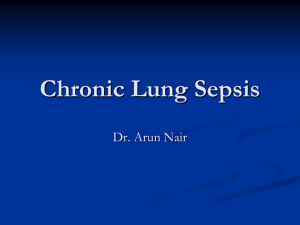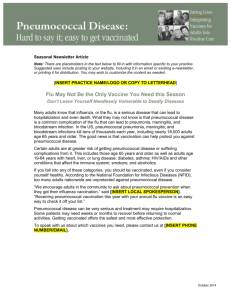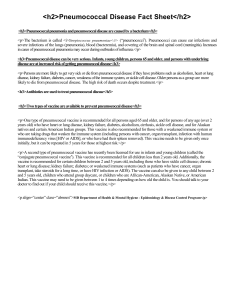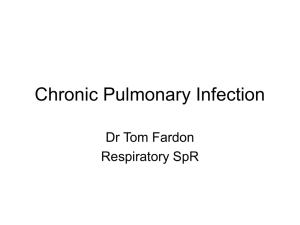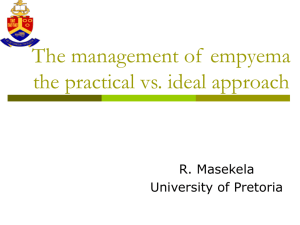Pneumococcal Empyema: Toronto, Ontario 1995-2006
advertisement
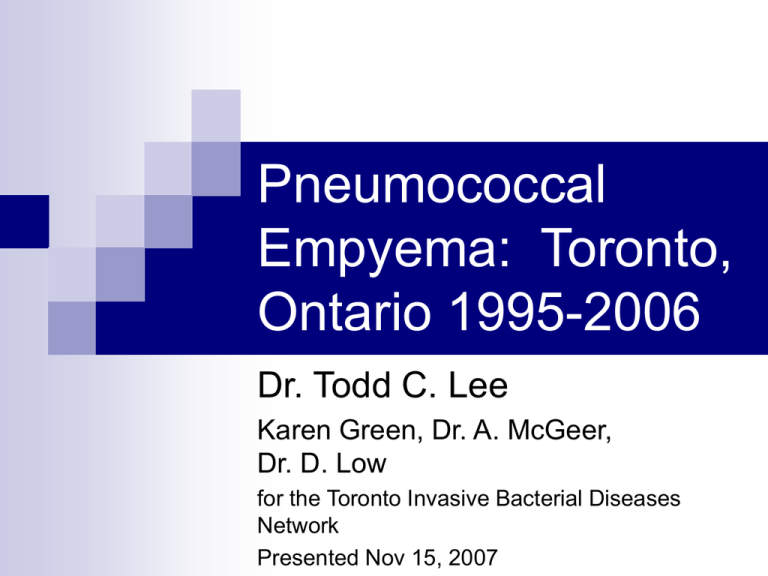
Pneumococcal Empyema: Toronto, Ontario 1995-2006 Dr. Todd C. Lee Karen Green, Dr. A. McGeer, Dr. D. Low for the Toronto Invasive Bacterial Diseases Network Presented Nov 15, 2007 What is Empyema? Empyema is an infection of the normally sterile pleural space Can be diagnosed when pleural fluid is floridly purulent. A complicated effusion is one that meets the criteria below (CID Dec 1, 2007) Microbiological diagnosis sputum culture pleural fluid culture blood culture or in some studies molecular techniques such as pleural fluid PCR or streptococcal antigen. Development of Empyema Why Study Empyema? Within the past several years and co-incident with (but perhaps predating) the introduction of the pneumococcal conjugate vaccine (PCV) in many jurisdictions there has been a dramatic reduction in the overall incidence of invasive pneumococcal disease (IPD). This is particularly noticeable for vaccine strain serotypes and this effect has been seen on multiple continents. Simultaneous increase in the incidence of pneumococcal empyema (PEMP) emergence of serotype 1 which is consistently associated with a disproportionate percentage The majority of studies have focussed on paediatric empyema. Ours would represent one of the largest studies of an adult predominant cohort of patients with empyema recently reported. Methods Population based surveillance for invasive pneumococcal disease has been ongoing through TIDBN since 1995. A database exists for the collection of clinical data from cases with information obtained from the patients themselves, their treating physicians, and retrospective chart review. This data is matched with microbiological data obtained from the isolates. Empyema in this study was defined as pleural fluid consistent with complicated pleural effusion or empyema with: (1) a positive pleural fluid culture for pneumococcus (2) a clinical diagnosis of empyema with positive blood culture for pneumococcus. Demographics Sex (no. % male) Age gp <15 yrs 15-64 >64 Institutionally acquired Hospital-acquired Nursing home acquired No underlying chronic illness Underlying illnesses Cardiac Lung Renal Diabetes mellitus Alcohol abuse HIV infection Antibiotic exposure Received any, last 3 mos Failing AB at presentation Outcome ICU Admission Mechanical Ventillation Death Non-empyema N=4744 2604 (55%) Empyema N=154 91 (59%) P value 1018 1740 1929 17 71 64 .004 204 (4.5%) 309 (6.8%) 2790/4671 (60%) (N=4608) 932/3660 (26%) 761/3659 (21%) 241/3660 (6.6%) 663/3372 (20%) 497/3150 (16%) 214/3002 (7.1%) 9 (4.0%) 6 (6.0%) 100/154 (65%) (N=117) 37/121 (31%) 37/121 (31%) 4/121 (3.3%) 17/114 (14.9%) 26/111 (23.4%) 5/110 (4.5%) NS NS NS 1116/3531 (32%) 205/2235 (9.2%) 28/113 (25%) 15/75 (20%) .12 .004 1044/4583 (22.8) 709/4560 (15.5) 889/4658 (19%) 59/153 (38.6) 45/152 (29.6) 31/154(20%) <0.001 <0.001 NS NS .21 .01 .15 .21 .03 .29 1.4 Population Based Rate (See Legend) 1.2 1 0.8 0.6 0.4 0.2 0 1996 1997 1998 1999 2000 2001 Non Empyema Per 10,000 2002 2003 Empyema Per 100,000 2004 2005 2006 Rates per 100,000 – Age Adjusted 1.8 1.6 1.4 1.2 1 0.8 0.6 0.4 0.2 0 1996 1997 1998 1999 2000 2001 Age <15 Age 15-64 2002 Age >=65 2003 2004 2005 2006 Microbiology Empyema as an Invasive Pneumococcal Disease Microbiology Serotype 1 Blood Culture Positive Pleural Fluid Culture Pos Both Positive Vaccine type causing infection Conjugate vaccine Polysaccharide vaccine Antibiotic resistance Penicillin TMP-SMX Erythromycin Ciprofloxacin Levofloxacin Moxifloxacin MDR (>=2 classes) Non-empyema Empyema P value 27/4309 (0.63) 4596/4772 (96.3) NA NA 6/136 (4.4%) 79/154(51.3%) 121/154 (78.5%) 46/121 (38%) <.001 <.001 NA NA 2456/4309 (57%) 3751/4309 (87%) N=4330 168 (3.9%) 847 (19.6%) 497 (11.5%) 51 (1.2%) 31 (0.8%) 9 (0.2%) 24/130(18%) 58/136 (43%) 116/136 (85%) N=137 7 (5.1%) 30 (21.9%) 24 (17.5%) 7 (5.3%) 6 (4.6%) 1 (0.8%) 501/4082(12%) <.001 .54 .6 .5 .03 <.001 <.001 .21 .04 Isolate Serotypes 14 16% OTHER 34% 3 11% 6B 7% 23F 4% 19F 4% 12F 4% 1 4% 9V 5% 6A 5% 7F 6% Conjugate Vaccine 4,6B, 9V, 14, 18C, 19F, 23F Polyvalent Vaccine 1 2 3 4 5 6B 7F 8 9N 9V 10A 11A 12F 14 15B 17F 18C 19F 19A 20 22F 23F 33F Vaccine Strains by Year 100.0 80.0 Percentage 60.0 CONJUGATE VACCINE PERCENTAGE POLYVALENT VACCINE PERCENTAGE 40.0 20.0 0.0 1996 1997 1998 1999 2000 2001 Year 2002 2003 2004 2005 2006 Clustering of Resistance Penicillin Erythromycin Resistant TMP/SMX Resistant Levofloxacin Resistant Erythromycin TMP/SMX Resistant Levofloxacin Resistant TMP/SMX Levofloxacin Resistance Conjugate Vaccine Serotypes Penicillin Resistance Erythromycin Resistance TMP/SMX Resistance Levofloxacin Resistance Polyvalent Vaccine Serotypes Penicillin Resistance Erythromycin Resistance TMP/SMX Resistance Levofloxacin Resistance Resistant Not-Resistant P value 11/20(55%) 15/20(75%) 0/20(0%) 13/117(11%) 15/117(13%) 6/111(5.4%) <.001 <.001 0.59 14/24 (58%) 1/24(4.2%) 16/116(14%) 5/107(4.7%) <.001 1 1/30(3.3%) 5/101(5.0%) 1 13/20 (65%) 15/24(63%) 19/30(63%) 1/6(17%) 45/116(39%) 43/112(39%) 39/106(37%) 53/124(43%) 0.048 0.04 0.01 0.4 18/20(90%) 21/24(88%) 23/30(77%) 3/6(50%) 98/116(85%) 95/112(85%) 93/106(88%) 108/124(87%) 0.7 1 0.015 0.04 Resistance to Multiple Agents Resistance to Multiple Agents MDR 12/24 (50%) NOT MDR 65/107 (61%) P value .36 4/24 (17%) 12/24 (50%) 8/24 (33%) 3/24 (13%) 0/24 (0%) 9/24 (38%) 13/106 (13%) 47/106 (44%) 46/106 (43%) 3/103 (3%) 8/103 (7.8%) 39/107 (36%) .6 ICU Ventilation Death 10/24 (42%) 5/24 (21%) 2/24 (8.3%) 41/106 (39%) 33/105 (31%) 26/107 (24%) .8 .45 .1 Positive Blood Culture 13/24 (54%) 56/107 (52%) 1 Conjugate Vaccine Serotypes Polyvalent Vaccine Serotypes 16/24 (67%) 20/24 (83%) 38/106 (36%) 91/106 (86%) 0.01 0.75 Male Age <15 15-64 >=65 Nursing Home Nosocomial Any Chronic Illness .08 .35 1 Resistance over Time Percentage of Resistant Isolates vs Time 45.0 40.0 35.0 30.0 25.0 Year PCN-R RATE LEV-R RATE MDR RATE 20.0 15.0 10.0 5.0 0.0 1996 1997 1998 1999 2000 2001 Percentage 2002 2003 2004 2005 2006 Outcomes Survival Deceased 21/31 (68%) Survived 70/123 (57%) P value .31 1/30 (3.3%) 8/30 (27%) 21/30 (70%) 5/29 (17%) 2/29 (6.9%) 5/31 (16%) 13/26 (50%) 10/31 (32%) 2/26 (7.7%) 10/26 (39%) 16/122 (13%) 63/122 (52%) 43/122 (35%) 1/120 (0.8%) 7/120 (5.8%) 49/123 (39%) 24/95 (25%) 17/123 (14%) 15/88 (17%) 16/85 (19%) .002 ICU Ventilation 17/30 (57%) 17/30 (57%) 42/123 (34%) 28/122 (23%) .04 .001 Positive Blood Culture 21/31 (68%) 58/123 (47%) .046 Conjugate Vaccine Serotypes Polyvalent Vaccine Serotypes Penicillin Resistant Erythromycin Resistant TMP/SMX Resisitant Levofloxacin Resistant MDR 8/28 (29%) 21/28 (75%) 4/28 (14%) 1/28 (3.6%) 3/28 (11%) 0/28 (0%) 2/28 (7.1%) 50/108 (46%) 95/108 (88%) 16/109 (15%) 23/109 (21%) 27/109 (25%) 6/103 (5.8%) 22/103 (21%) 0.13 0.13 1 .03 0.13 0.34 .1 Male Age <15 15-64 >=65 Nursing Home Nosocomial No Chronic Illness Lung Disease Cardiac Disease Diabetes Alcohol .001 .69 .02 .03 .03 .35 .06 ICU Admissions and Deaths By Year Complications by Year 60.0 50.0 40.0 ICU Admission 30.0 Case Fatality Rate 20.0 10.0 0.0 1996 1997 1998 1999 2000 2001 2002 2003 2004 2005 2006 Limitations Culture negative pneumococcal empyema and patients with sputum cultures only would not be captured by our surveillance. Eltringham G, Kearns A, Freeman R, Clark J, Spencer D, Eastham K, et al. Culture-negative childhood empyema is usually due to penicillin-sensitive Streptococcus pneumoniae capsular serotype 1. J Clin Microbiol 2003 Jan;41(1):521-2. ~70% of culture negative were pneumoccoccus according to PCR assays. ~60% of these were serotype 1 Examining complicated pleural effusion and empyema rather than empyema exclusively Limited access (at this point) to patient specific data Conclusions In our cohort of patients with pneumococcal empyema: Population based rates were highest in patients older than 65 Cases more likely to be alcohol abusers or have underlying lung disease Cases were more likely to be failing outpatient therapy There was a high morbidity (40% ICU admission) and mortality (20% death) associated with pneumococcal empyema Death associated with underlying disease states and more severe illness Serotype 1 was more common in empyema than in other IPD Isolates found in empyema were more likely to be resistant to macrolides, ciprofloxacin (not shown) and levofloxacin but not penicillin or moxifloxacin Acknowledgements Refik Saskin Karen Green Dr. Allison McGeer Dr. D. Low Toronto Invasive Bacterial Diseases Network References 1. Aspa J, Rajas O, Rodriguez de Castro F, Blanquer J, Zalacain R, Fenoll A, et al. Drug-resistant pneumococcal pneumonia: clinical relevance and related factors. Clin Infect Dis 2004 Mar 15;38(6):787-98. 2. Barnes NP, Hull J, Thomson AH. Medical management of parapneumonic pleural disease. Pediatr Pulmonol 2005 Feb;39(2):127-34. 3. Buckingham SC, King MD, Miller ML. Incidence and etiologies of complicated parapneumonic effusions in children, 1996 to 2001. Pediatr Infect Dis J 2003 Jun;22(6):499-504. 4. Byington CL, Korgenski K, Daly J, Ampofo K, Pavia A, Mason EO. Impact of the pneumococcal conjugate vaccine on pneumococcal parapneumonic empyema. Pediatr Infect Dis J 2006 Mar;25(3):250-4. 5. Byington CL, Samore MH, Stoddard GJ, Barlow S, Daly J, Korgenski K, et al. Temporal trends of invasive disease due to Streptococcus pneumoniae among children in the intermountain west: emergence of nonvaccine serogroups. Clin Infect Dis 2005 Jul 1;41(1):21-9. 6. Byington CL, Spencer LY, Johnson TA, Pavia AT, Allen D, Mason EO, et al. An epidemiological investigation of a sustained high rate of pediatric parapneumonic empyema: risk factors and microbiological associations. Clin Infect Dis 2002 Feb 15;34(4):434-40. 7. Calbo E, Diaz A, Canadell E, Fabrega J, Uriz S, Xercavins M, et al. Invasive pneumococcal disease among children in a health district of Barcelona: early impact of pneumococcal conjugate vaccine. Clin Microbiol Infect 2006 Sep;12(9):867-72. 8. Carratala J, Martin-Herrero JE, Mykietiuk A, Garcia-Rey C. Clinical experience in the management of community-acquired pneumonia: lessons from the use of fluoroquinolones. Clin Microbiol Infect 2006 May;12 Suppl 3:2-11. 9. Eltringham G, Kearns A, Freeman R, Clark J, Spencer D, Eastham K, et al. Culture-negative childhood empyema is usually due to penicillinsensitive Streptococcus pneumoniae capsular serotype 1. J Clin Microbiol 2003 Jan;41(1):521-2. 10. Fletcher M, Leeming J, Cartwright K, Finn A, South West of England Invasive Community Acquired Infection Study,Group. Childhood empyema: limited potential impact of 7-valent pneumococcal conjugate vaccine. Pediatr Infect Dis J 2006 Jun;25(6):559-60. 11. Giachetto G, Pirez MC, Nanni L, Martinez A, Montano A, Algorta G, et al. Ampicillin and penicillin concentration in serum and pleural fluid of hospitalized children with community-acquired pneumonia. Pediatr Infect Dis J 2004 Jul;23(7):625-9. 12. Liapakis IE, Kottakis I, Tzatzarakis MN, Tsatsakis AM, Pitiakoudis MS, Ypsilantis P, et al. Penetration of newer quinolones in the empyema fluid. Eur Respir J 2004 Sep;24(3):466-70. 13. Le Monnier A, Carbonnelle E, Zahar JR, Le Bourgeois M, Abachin E, Quesne G, et al. Microbiological diagnosis of empyema in children: comparative evaluations by culture, polymerase chain reaction, and pneumococcal antigen detection in pleural fluids. Clin Infect Dis 2006 Apr 15;42(8):1135-40. 14. Obando I, Arroyo LA, Sanchez-Tatay D, Moreno D, Hausdorff WP, Brueggemann AB. Molecular typing of pneumococci causing parapneumonic empyema in Spanish children using multilocus sequence typing directly on pleural fluid samples.comment. Pediatr Infect Dis J 2006 Oct;25(10):962-3. 15. Paganini H, Guinazu JR, Hernandez C, Lopardo H, Gonzalez F, Berberian G. Comparative analysis of outcome and clinical features in children with pleural empyema caused by penicillin-nonsusceptible and penicillin-susceptible Streptococcus pneumoniae. Int J Infect Dis 2001;5(2):86-8. 16. Schultz KD, Fan LL, Pinsky J, Ochoa L, Smith EO, Kaplan SL, et al. The changing face of pleural empyemas in children: epidemiology and management. Pediatrics 2004 Jun;113(6):1735-40. 17. Tan TQ, Mason EO,Jr, Wald ER, Barson WJ, Schutze GE, Bradley JS, et al. Clinical characteristics of children with complicated pneumonia caused by Streptococcus pneumoniae. Pediatrics 2002 Jul;110(1 Pt 1):1-6.

